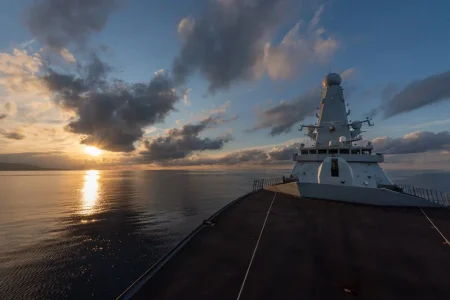USN:
Iowa class battleship USS Wisconsin (BB-64) coming along side oiler USS Taluga (AO-62) for fuelling. January 1945
Ex-USS Stewart (DD-224) under attack while being sunk as a target on 24 May 1946. Airplanes seen include an F4U Corsair in the lead, followed by two F6F Hellcats
Stewart was one of the better variants of the WWI-era
Clemson class destroyers (suffice to say some built good ships and others bad ones), and spent almost her entire 22 year service life as part of the Asiatic Fleet based in the Philippines, including several operations in Chinese waters to protect Americans from the various warring factions in the country, especially Japan. As of late 1941, the 13 Asiatic Fleet
Clemsons were the only flush deck destroyers still in front-line service, with others modified for anti-submarine duty, attached to naval districts (including
Ward), or modified into a few different specialized variants. Along with the heavy cruiser
Houston, the old light cruiser
Marblehead, and 29 submarines (23 of them among the most modern available), this was the primary combat arm of the Asiatic Fleet. The US expected a Japanese attack and did not want to put more units in Chinese waters that had a low chance of survival (hence the heavy submarine presence).
As war alerts came,
Stewart and her fellow ships left the Philippines to avoid being caught in a surprise attack. She was in the Dutch East Indies when the Japanese attacked, and as part of the combined American-British-Dutch-Austalian Command fought a heroic series of delaying actions against the Japanese. Most of these resulted in a Japanese victory, and ultimately losses were heavy, especially among the Dutch forces.
Stewart was badly damaged at the Battle of Badung Strait and returned to Surabaya for repairs. As the most damaged ship she was the first to enter the floating drydock on 22 February, and also the last Allied ship as she fell off the blocks and onto her side. With even more severe damage and an imminent threat of falling into Japanese hands, the drydock and the destroyer in it were scuttled.
Stewart was stricken from the Naval Vessel Register and her name assigned to a brand new destroyer escort, DE-238.
The Japanese found the ship and raised her in February 1943. While completely unsuitable as a destroyer, she could still serve as a patrol boat, and on 20 September 1943 she was commissioned as
Patrol Boat No. 102 (one of nine Allied ships designated patrol boats, though not all became operational). She operated as a convoy escort in the southwest Pacific for the rest of the war, often plagued with boiler troubles as the long immersion in.
On 6 May 1944 the submarine USS
Gunard spotted the Japanese Take Convoy, which included
PB-102 as an escort. Three ships are ultimately sunk, and
Gunard survives the 98 depth charges from the convoy escorts. On 14 June 1944,
Rasher sank another of
PB-102's charges, and on 23 August she was sent to protect another convoy attacked by three US submarines.
Haddo departed before
PB-102 arrived (out of torpedoes), but
Hake and
Harder remained.
Hake did not like the setup and broke off, but
Harder remained and attacked
CD-22: both torpedoes missed, and the escort eventually sank the submarine with all hands. Meanwhile,
PB-102 escorted the damaged
Niyo Maru to Manila. Commander Samuel D. Dealey, the Destroyer Killer, was posthumously awarded the Medal of Honor.
More submarines sank
PB-102's charges and fellow escorts in November and December, but escape. Arriving in Japan in January 1945 for refit, in 1945
PB-102 had to fight off bombers, and was damaged by PBYs on 27 and 28 April, losing steering control for a time. She returned to Japan, made a couple more runs, and survived the war relatively intact. US inspectors found her rat-infested and decrepit, but clean the ship and hoist the American Flag over her once again. on 29 October 1945 she was recommissioned in the US Navy, as
DD-224 thanks to the still-extant destroyer escort (which still survives today in Galveston, Texas). It takes four months to reach the US, much of that under tow, but once she reaches California she is briefly opened for local tours. Soon decommissioned and stricken (again), she was sunk in this life fire exercise.






